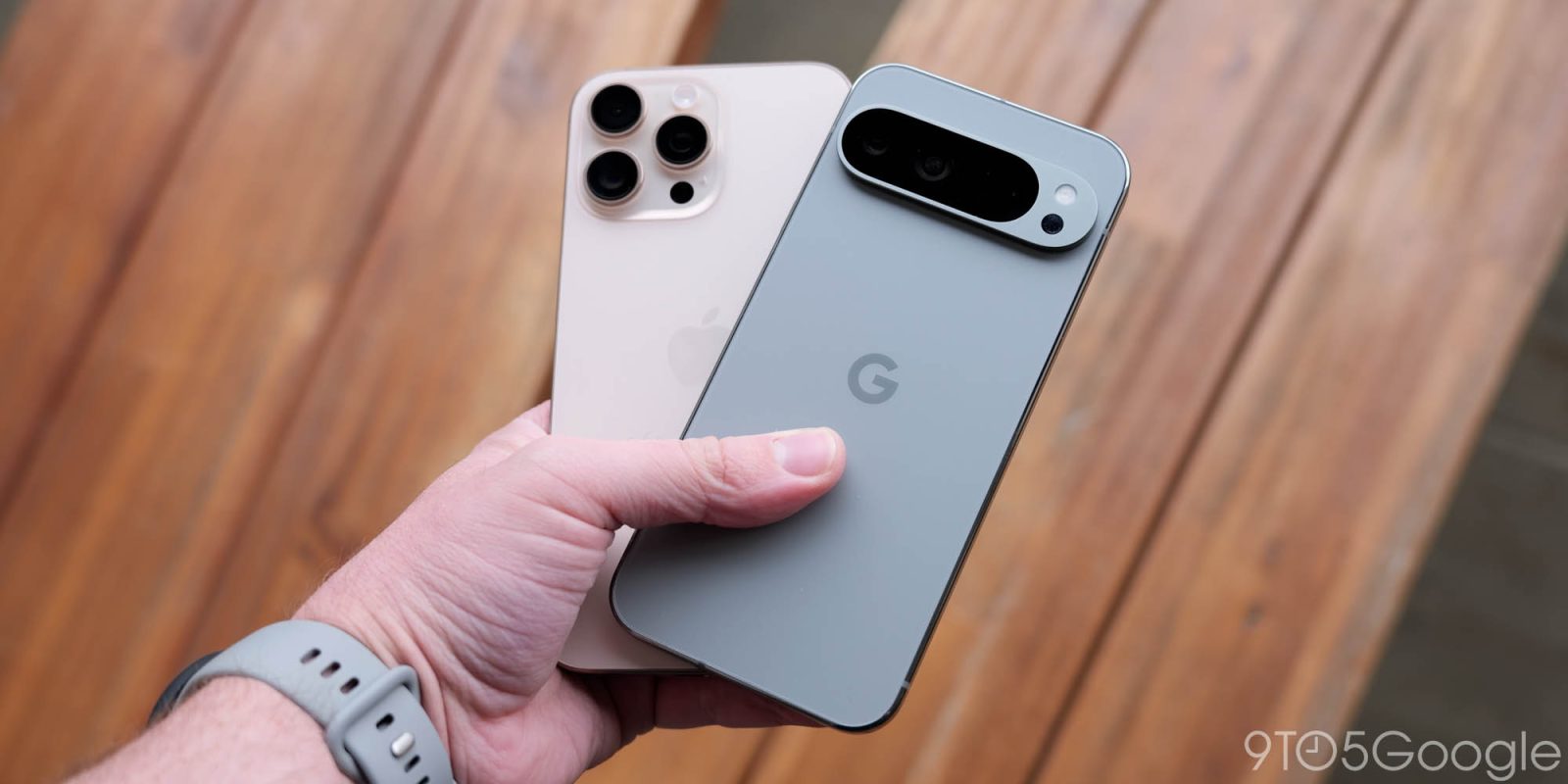
We’ve seen Google take a few cues from Apple over the years. The result of following a tried-and-tested playbook is a very similar-looking handset no matter what side of the fence you fall on. How does the Pixel 9 Pro XL stack up against the iPhone 16 Pro Max? Here’s what you need to know.
Before we start comparing Apples to Googles, we must acknowledge that things can’t be like-for-like. If you’re an Android person – like us – you probably don’t care about iOS things. If you’re an iOS person, you probably don’t care about Android. That’s absolutely fine, but in the interest of seeing just how far Google has come, it wouldn’t be fair if we didn’t at least see how the market leading smartphone maker compares to the minnow.
Table of contents
Hardware and design
Google certainly understood the brief when it came to making an iPhone clone. There is more than a little homage being played with the entire Pixel 9 series to the iPhone. The Pixel 9 Pro XL and iPhone 16 Pro Max could be mistaken for siblings if it were not for a few design alterations.
This duo is big. The Pixel 9 Pro XL has a 6.8-inch screen, while the iPhone 16 Pro Max has a 6.9-inch screen. Note that this is just the screen size. The dimensions are substantial, but the iPhone is just a few millimeters taller, wider, and 6g heavier. It’s hard to distinguish between these phones careless.

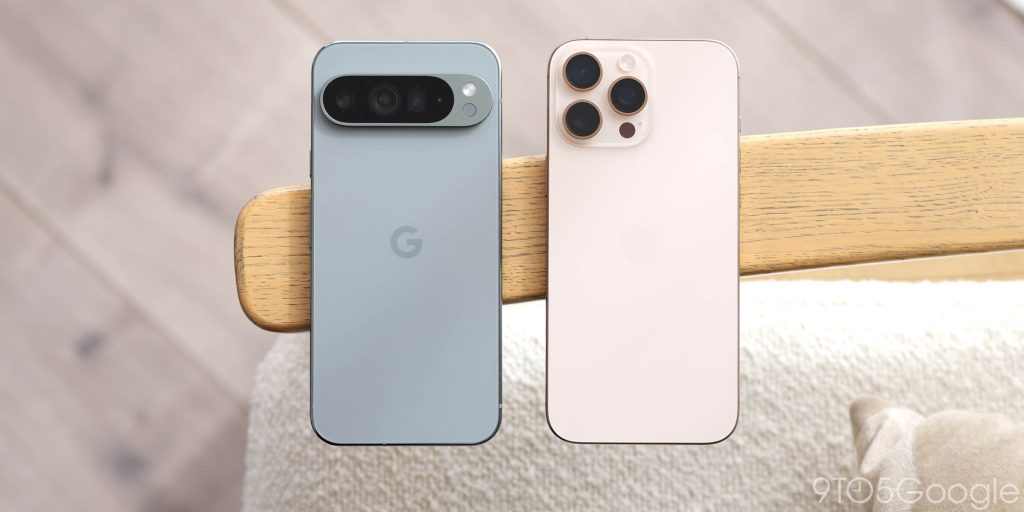
The fit and finish is very similar owing to the shapes, but Google has kept things lighter with aluminum. Apple prefers titanium. The matte sides and muted colors give the iPhone 16 Pro Max a marginally more cohesive look, while the Pixel 9 Pro XL fuses gloss and matte. Logos aside, the camera bar is the only dead giveaway that these devices are not from the same company.
| Google Pixel 9 Pro XL | iPhone 16 Pro Max | |
|---|---|---|
| Size | 6.8-inch | 6.9-inch |
| Dimensions | 162.8 x 76.6 x 8.5 mm | 163 x 77.6 x 8.3 mm |
| Weight | 221g | 227g |
| Display | 120Hz / LTPO / QHD+ / Gorilla Glass Victus 2 / 1,344 x 2,992 pixels / 486ppi / 3000 nits | 120Hz / LTPO / QHD+ / Ceramic Shield / 1,320 x 2,868 pixels / 460ppi / 2000 nits |
| Chipset | Google Tensor G4 (4nm) | Apple A18 Pro (3nm) |
| RAM | 16GB | 8GB |
| Storage | 128 / 256 / 512 / 1TB UFS 3.1 | 256 / 512 / 1TB NVMe |
| Battery | 5,060mAh | 4,685mAh |
| Rear camera | 50MP wide / 48MP ultra-wide / 48MP telephoto | 48MP wide / 48MP ultra-wide / 12MP telephoto |
| Front-facing camera | 42MP | 12MP |
| Biometrics | In-display Ultrasonic fingerprint / 2D Face Unlock | 3D Face Unlock |
| Colors | Obsidian / Porcelain / Hazel / Rose Quartz | Black Titanium / White Titanium / Natural Titanium / Desert Titanium |
Another change is the placement of buttons. Apple now has two extra buttons: the “Action” button and the new camera control. The new camera toggle lets you control some of the UI while taking photos and recording videos. It’s actually pretty underwhelming, much like the Action button.
If you want more vibrant color options, Google has you covered this year. You can go for a signature Hazel or even more standout Rose Quartz alongside standard black and white options. Apple has added a “Desert Titanium” color, which is akin to champagne or rose gold, alongside silver, white, and black variants. It’s hard to argue, though, that Google’s decision to stick with glossy side rails hasn’t cheapened the appeal.
Displays
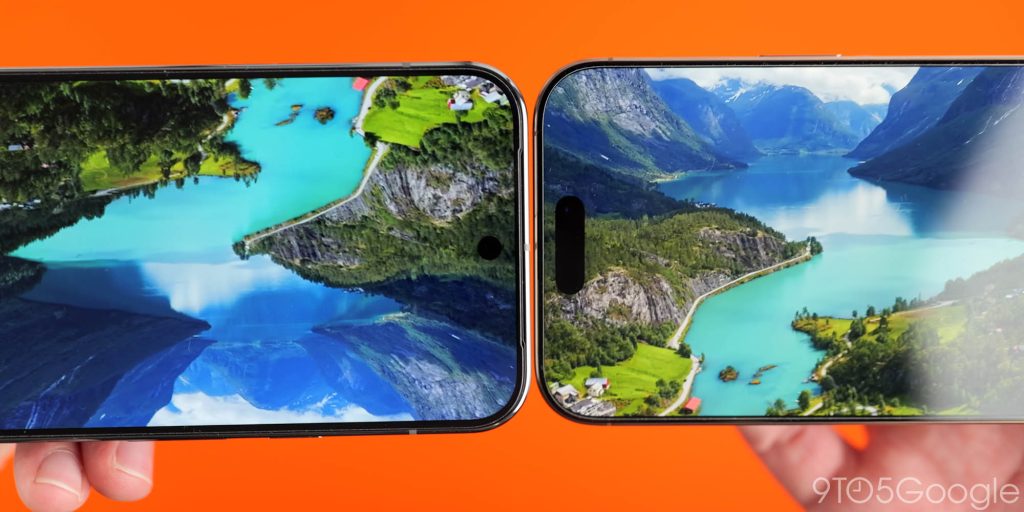
For the first time, a Google Pixel can tout an arguably better display than an iPhone. Apple has managed to outdo Android with some seriously tiny bezels on the iPhone 16 Pro Max. It also has a lower minimum brightness, but the Pixel 9 Pro XL’s display is brighter, has a higher resolution, and is better overall for all types of content.
The iPhone 16 Pro Max’s “Dynamic Island” notch implementation also obscures a substantial section of your screen if you want to watch movies or play games in full-screen landscape orientation. A tiny punchhole on the Pixel 9 Pro XL doesn’t offer any 3D face-scanning tech, but it is less distracting and doesn’t have any gimmicks baked in to try and justify its size.
In reality, both Pixel 9 Pro XL and iPhone 16 Pro Max have exceptional panels that elevate all types of content. The 120Hz refresh rate is also felt when you’re zipping through menus or scrolling through apps.
Software and performance

There are many differences between Android and iOS that we could explore with this comparison, but the biggest variation for 2024 and beyond is how AI is being integrated. Google has actually shipped most of the AI functions with the Pixel 9 Pro XL, while Apple did not with the iPhone 16 Pro Max.
Apple Intelligence will be released in beta over the next few months. Some of the headline functionality is not expected until 2025. Google even powers some camera-based functions, which feels completely at odds with how iOS has previously been siloed away and completely separate to whatever the industry does. Artificial Intelligence could be a great leveler for our mobile operating systems.
Now, in the raw performance stakes, the iPhone absolutely outperforms the Pixel in just about every area and metric. That’s likely why lots of Gemini-powered features are packed in like Add Me, Pixel Screenshots, Pixel Studio, and much more. Google can outmuscle Apple in terms of AI processing and functionality. AI-powered features like Magic Editor in tandem with Reimagine are superior to the “Clean Up” option on iPhone – which is only available in the iOS 18.1 Beta.
Gemini Live is another area where Siri simply cannot compete. It’s not exactly the best feature, but conversational interactions with AI can be much more concise than a chatbot that is only able to answer one query at a time.
If you just want the most powerful phone and don’t care about AI – which is hard to blame someone for – then the iPhone 16 Pro Max is without question the best smartphone in the industry. Period.
Where things get a bit interesting is in the support window for this duo. It’s practically identical to Google, promising 7 years of regular updates and software support. Apple isn’t as concrete, but 7 years would be par for the course and in keeping with previous flagship iPhone support windows.
Battery
To be honest, over the years Apple has done incredible things with such small internal batteries in flagship phones. It’s the exact same once again. The Pixel 9 Pro XL has a larger 5,060mAh battery but the substantially smaller iPhone 16 Pro Max’s 4,685mAh battery is a pure powerhouse.
When the chips are down, it’ll outlast just about every Android phone in daily usage or even in a stress test. The Pixel 9 Pro XL has “good” longevity. It’s far from the best in the business, but it should provide most people with enough overhead, even if you are glued to the screen.
There are some differences in charging speeds that favor the Pixel. You get faster 37W wired charging and 23W wireless charging with the Pixel Stand. According to public specs, Apple has stuck with 25W wired charging but slightly faster 25W wireless charging with supported Qi2 pads. Real-world tests suggest that the iPhone 16 series actually charges faster at almost 32W with a 65W power brick. Neither phone is “fast” in the traditional sense, but fairly similar when you’re charging back to 100%. The difference is how often you’re charging.
Cameras
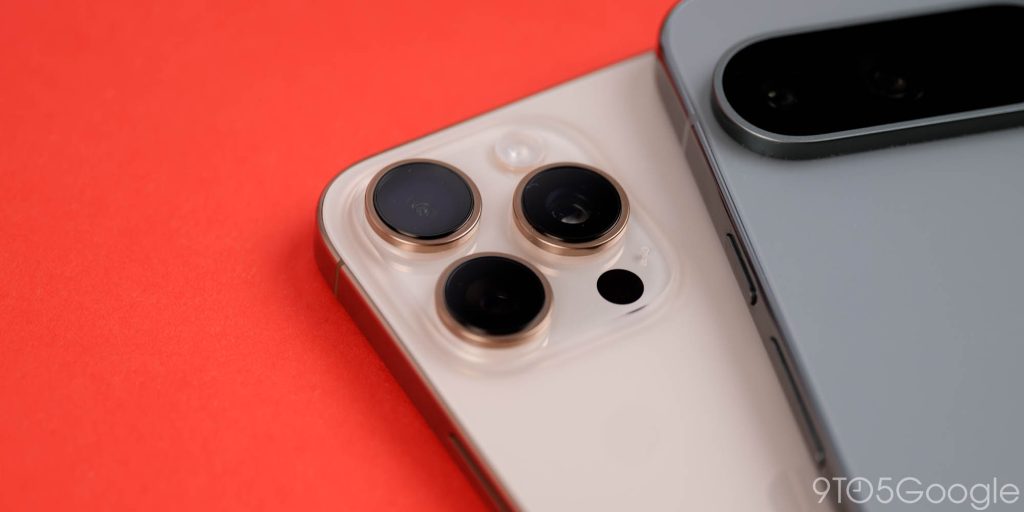

There aren’t as many upgrades to shout about in the camera stakes this time around, but what has changed makes a surprising difference to the Pixel 9 Pro XL and iPhone 16 Pro Max. Google has upgraded the selfie camera and 5x telephoto. The rest of the hardware is identical to the Pixel 8 Pro.
The iPhone 16 Pro Max features an improved ultrawide lens and a new camera control button. Like the Pixel, the rest of the hardware is identical to its predecessor.
Each system excels in specific scenarios. Zoom photos are a strength of the Pixel. Natural tones favor the iPhone. Everywhere else, it’s a toss-up based on what you’re preferred photograph style is. It’s tough to decide which is objectively the better camera system because of how they process the final shot.
If you are a big-time selfie taker, you might want to take a look at the Pixel. The upgraded 42MP sensor produces tack-sharp photos that are full of detail. Real Tone also means that skin tones are accurately rendered—something the iPhone has struggled with and continues to struggle with year after year.
Despite going toe-to-toe in still photography modes, there is less competition when we start to discuss video capabilities. The Pixel 9 Pro XL is the best Google can muster for video recording, but it relies heavily on Video Boost to compete with the iPhone. It’s impressive that you can shoot 8K and 4K videos, which are improved drastically when they have been processed. It just takes a while and will use extensive data and storage space.
It actually makes it all the more impressive that the iPhone 16 Pro Max can do 4K up to 120fps on-device without any limitations – save the use of an external drive and storage capacity. As noted, you can even record to external SSD using the default camera application, too – something not possible on Pixel without a third-party app.
LOG and ProRes are just some of the biggest selling points of the iPhone series in recent years. The ability to shoot professional formats with class-leading video quality is not to be undersold. No Android phones even come close to what Apple has been doing with moving images, but we hope that we will get more improvements on Pixel soon.
Pixel 9 Pro XL vs. iPhone 16 Pro Max: Has Google caught up?
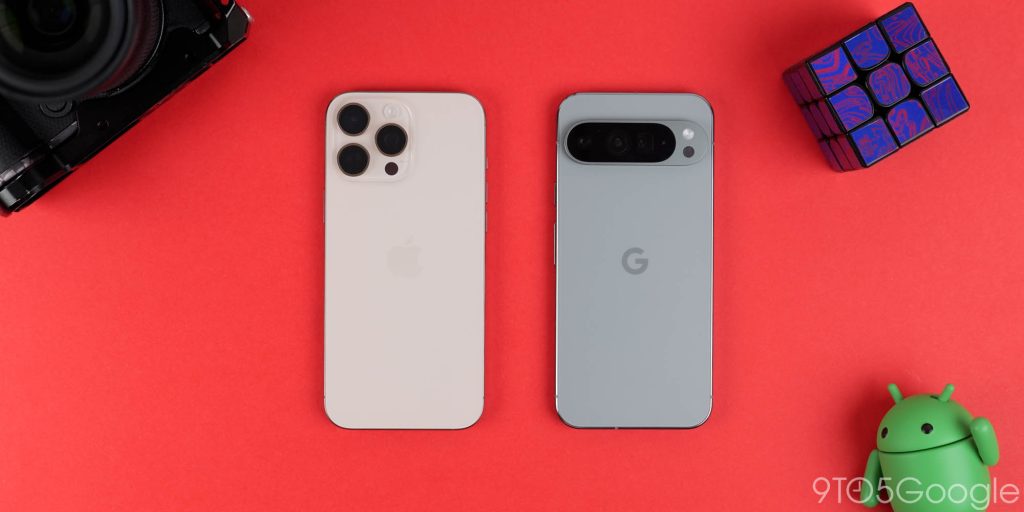
About upgrading: 9to5Google often gives specific product recommendations. Sometimes, we may suggest not upgrading, due to various reasons including, but not limited to: increased device cost, negligible performance gains, or environmental impact. Whether to upgrade is always your call, but our aim is to help you make as informed a decision as possible.
One of the home truths about Android and iOS is that converts to the latter rarely come back. Most people who drop an Android phone in favor of an iPhone are unlikely to ever make the return switch. However, the iPhone 16 Pro Max is a very minor upgrade over the iPhone 15 Pro Max. Google has been making strides in recent years.
There isn’t and has never been a “perfect Pixel,” but an imperfect iPhone and notable improvements to Google’s core formula could pick up a few potential converts. I’m biased, I prefer Android. However, the iPhone 16 Pro Max is, once again, a very good smartphone that although only offers some very small upgrades, is going to make people happy.
Get the Pixel 9 Pro XL
FTC: We use income earning auto affiliate links. More.




Comments